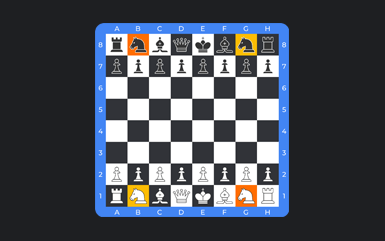The Knight Chess Piece – Starting Position, Movements, Values, and Role
Stepping into the world of chess, you’ll find each piece carries unique movements and strategies, contributing to the richness of the game. Among them, the Knight stands out for its distinctive move and tactical prowess. Today, we’ll discuss the Knight’s characteristics, movement, value, and tactics to help beginners understand and effectively utilize this powerful piece.
What is a Knight?
In the game of chess, the Knight is a piece symbolized by the head of a horse. Knights are unique in their movement, with the ability to ‘jump’ over other pieces. Each player begins with two Knights in a standard chess game.
Where does the Knight Start on the Board?
The Knights are placed on the board next to the Rooks (or Castles). In standard algebraic notation, the white Knights start on squares b1 and g1, while the black Knights start on squares b8 and g8.
How does the Knight Move on the Chessboard?
The Knight moves in a unique pattern that sets it apart from all other chess pieces: it moves in an ‘L’ shape, two squares in one direction, and then one square perpendicular to the first direction. The Knight is also the only piece that can ‘jump’ over other pieces, making it extremely versatile, especially in the early stages of the game when the board is crowded.
How much Points is Knight Worth?
In the point system that reflects the relative values of pieces in chess, a Knight is worth 3 points, similar to a Bishop. However, the value of a Knight can fluctuate significantly based on the position on the board, due to its unique movement pattern.
What is the Role of the Knight in Chess?
The role of the Knight varies throughout different phases of the game. In the opening, Knights are often developed early to control the center and to enable the player to castle. In the middlegame, Knights are excellent at exploiting weaknesses in the opponent’s position, especially outposts, where a Knight is defended by a pawn and cannot be attacked by an enemy pawn. In the endgame, the Knight’s ability to jump over pieces can become a crucial factor, especially in closed positions.
How to Maximize the Knight’s Potential in Chess?
To make the most of your Knight, consider the following strategies:
- Outposts: Knights are at their most potent on outposts, especially in the opponent’s half of the board. These are squares protected by your pawn, from which the Knight cannot be chased by enemy pawns.
- Closed Positions: Knights excel in closed positions with many pawns on the board, where the Knight’s ability to jump over pieces gives it a mobility advantage.
- Forking Opportunities: The Knight’s unique movement often allows it to fork two or more enemy pieces, creating tactical opportunities.
Are there any Special Rules for the Knight?
The Knight doesn’t have any special rules or moves like castling or en passant. However, its unique movement pattern allows it to ‘jump’ over other pieces, making the Knight especially powerful in complex positions.
Alternative Names for the Knight Chess Piece?
In different languages, the Knight is referred to by different names. In German, it’s ‘Springer,’ in Spanish, it’s ‘Caballo,’ and in French, it’s ‘Cavalier.’ In English, however, ‘Knight’ is the universally accepted term.
Conclusion
The Knight, with its distinctive L-shaped move, is a versatile and tactical piece on the chessboard. Understanding its strengths and weaknesses, and knowing when and how to deploy it, can significantly enhance your gameplay. Remember, a well-placed Knight can often be the key to a stunning victory. Happy gaming!




 Protected by Patchstack
Protected by Patchstack
0 Comments